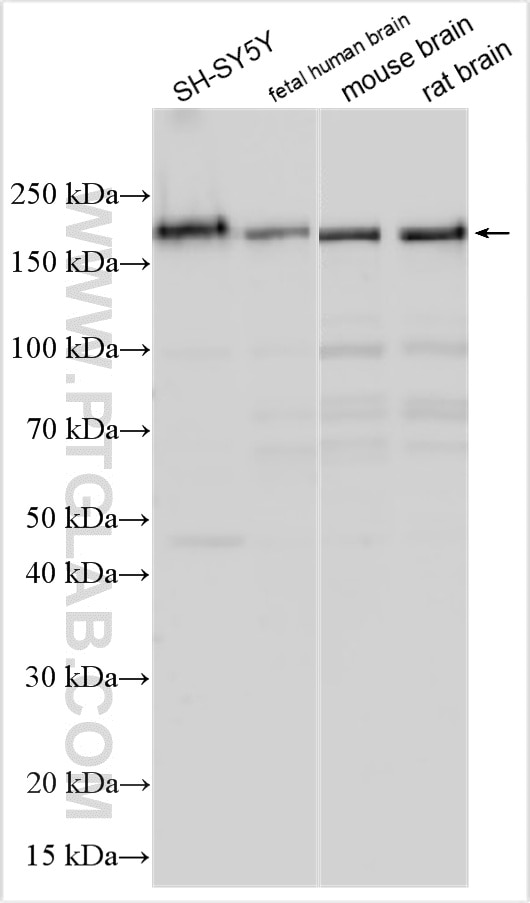Tested Applications
| Positive WB detected in | SH-SY5Y cells, fetal human brain tissue, mouse brain tissue, rat brain tissue |
Recommended dilution
| Application | Dilution |
|---|---|
| Western Blot (WB) | WB : 1:6000-1:12000 |
| It is recommended that this reagent should be titrated in each testing system to obtain optimal results. | |
| Sample-dependent, Check data in validation data gallery. | |
Product Information
32938-1-AP targets TTBK1 in WB, ELISA applications and shows reactivity with human, mouse, rat samples.
| Tested Reactivity | human, mouse, rat |
| Host / Isotype | Rabbit / IgG |
| Class | Polyclonal |
| Type | Antibody |
| Immunogen | TTBK1 fusion protein Ag36655 Predict reactive species |
| Full Name | tau tubulin kinase 1 |
| Calculated Molecular Weight | 142/70 kDa |
| Observed Molecular Weight | 200 kDa |
| GenBank Accession Number | BC036764 |
| Gene Symbol | TTBK1 |
| Gene ID (NCBI) | 84630 |
| Conjugate | Unconjugated |
| Form | Liquid |
| Purification Method | Antigen affinity Purification |
| UNIPROT ID | Q5TCY1 |
| Storage Buffer | PBS with 0.02% sodium azide and 50% glycerol, pH 7.3. |
| Storage Conditions | Store at -20°C. Stable for one year after shipment. Aliquoting is unnecessary for -20oC storage. 20ul sizes contain 0.1% BSA. |
Background Information
TTBK1 (Tau Tubulin kinase 1), also known as BDTK (brain-derived Tau kinase), is a 1,321 amino acid protein that contains one protein kinase domain and belongs to the serine/threonine protein kinase family. Localized to the cytoplasm and expressed at high levels in brain and at lower levels in testis and spinal cord, TTBK1 functions as a serine/threonine kinase that can phosphorylate Tau (a protein involved in Tubulin polymerization) on threonine, tyrosine and serine residues. Specifically, TTBK1 uses divalent cations, such as magnesium and manganese, to catalyze the ATP-dependent transfer of a phosphate group onto Tau, creating a phosphoprotein and ADP. Phosphorylation of Tau causes its aggregation and subsequent loss of function, suggesting an important role for TTBK1 in the control of Tubulin dynamics. Two isoforms of TTBK1 are expressed due to alternative splicing events. The molecular weight observed is consistent with what has been described in PMID:16923168.
Protocols
| Product Specific Protocols | |
|---|---|
| WB protocol for TTBK1 antibody 32938-1-AP | Download protocol |
| Standard Protocols | |
|---|---|
| Click here to view our Standard Protocols |



